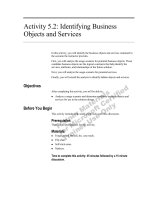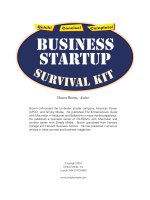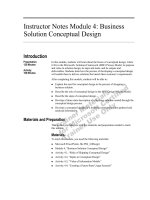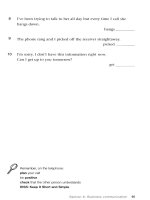Business analytics evans analytics2e ppt 01
Bạn đang xem bản rút gọn của tài liệu. Xem và tải ngay bản đầy đủ của tài liệu tại đây (4.31 MB, 47 trang )
Chapter 1
Introduction to
Business Analytics
Business Analytics
(Business) Analytics is the use of:
data,
information technology,
statistical analysis,
quantitative methods, and
mathematical or computer-based models
to help managers gain improved insight about
their business operations and make better, factbased decisions.
Examples of Applications
Pricing
◦ setting prices for consumer and industrial goods, government
contracts, and maintenance contracts
Customer segmentation
◦ identifying and targeting key customer groups in retail, insurance,
and credit card industries
Merchandising
◦ determining brands to buy, quantities, and allocations
Location
◦ finding the best location for bank branches and ATMs, or where to
service industrial equipment
Social Media
◦ understand trends and customer perceptions; assist marketing
managers and product designers
Evolution of Business Analytics
Business intelligence
Information Systems
Statistics
Operations research/Management science
Decision support systems
A Visual Perspective of Business
Analytics
Impacts and Challenges
Benefits
◦ …reduced costs, better risk management, faster
decisions, better productivity and enhanced bottom-line
performance such as profitability and customer
satisfaction.
Challenges
◦ …lack of understanding of how to use analytics,
competing business priorities, insufficient analytical skills,
difficulty in getting good data and sharing information,
and not understanding the benefits versus perceived
costs of analytics studies.
Scope of Business Analytics
Descriptive analytics: the use of data to
understand past and current business
performance and make informed decisions
Predictive analytics: predict the future by
examining historical data, detecting patterns or
relationships in these data, and then extrapolating
these relationships forward in time.
Prescriptive analytics: identify the best
alternatives to minimize or maximize some
objective
Tools
Database queries and analysis
Dashboards to report key performance measures
Data visualization
Statistical methods
Spreadsheets and predictive models
Scenario and “what-if” analyses
Simulation
Forecasting
Data and text mining
Optimization
Social media, web, and text analytics
Example 1.1: Retail Markdown Decisions
Most department stores clear seasonal inventory
by reducing prices.
Key question: When to reduce the price and by
how much to maximize revenue?
Potential applications of analytics:
Descriptive analytics: examine historical data for similar
products (prices, units sold, advertising, …)
Predictive analytics: predict sales based on price
Prescriptive analytics: find the best sets of pricing and
advertising to maximize sales revenue
Software Support
IBM Cognos Express
◦ An integrated business intelligence and planning solution
designed to meet the needs of midsize companies,
provides reporting, analysis, dashboard, scorecard,
planning, budgeting and forecasting capabilities.
SAS Analytics
◦ Predictive modeling and data mining, visualization,
forecasting, optimization and model management,
statistical analysis, text analytics, and more.
Tableau Software
◦ Simple drag and drop tools for visualizing data from
spreadsheets and other databases.
Data for Business Analytics
Data: numerical or textual facts and figures that
are collected through some type of measurement
process.
Information: result of analyzing data; that is,
extracting meaning from data to support
evaluation and decision making.
Examples of Data Sources and Uses
Annual reports
Accounting audits
Financial profitability analysis
Economic trends
Marketing research
Operations management performance
Human resource measurements
Web behavior
page views, visitor’s country, time of view, length of time, origin
and destination paths, products they searched for and viewed,
products purchased, what reviews they read, and many others.
Data Sets and Databases
Data set - a collection of data.
◦ Examples: Marketing survey responses, a table of
historical stock prices, and a collection of measurements
of dimensions of a manufactured item.
Database - a collection of related files containing
records on people, places, or things.
◦ A database file is usually organized in a two-dimensional
table, where the columns correspond to each individual
element of data (called fields, or attributes), and the rows
represent records of related data elements.
Example 1.2: A Sales Transaction
Database File
Records
Entities
Fields or Attributes
Big Data
Big data to refer to massive amounts of business data
from a wide variety of sources, much of which is
available in real time, and much of which is uncertain or
unpredictable. IBM calls these characteristics volume,
variety, velocity, and veracity.
“The effective use of big data has the potential to
transform economies, delivering a new wave of
productivity growth and consumer surplus. Using big
data will become a key basis of competition for existing
companies, and will create new competitors who are
able to attract employees that have the critical skills for a
big data world.” - McKinsey Global Institute, 2011
Metrics and Data Classification
Metric - a unit of measurement that provides a
way to objectively quantify performance.
Measurement - the act of obtaining data
associated with a metric.
Measures - numerical values associated with a
metric.
Types of Metrics
Discrete metric - one that is derived from
counting something.
◦ For example, a delivery is either on time or not; an order
is complete or incomplete; or an invoice can have one,
two, three, or any number of errors. Some discrete
metrics would be the proportion of on-time deliveries; the
number of incomplete orders each day, and the number
of errors per invoice.
Continuous metrics are based on a continuous
scale of measurement.
◦ Any metrics involving dollars, length, time, volume, or
weight, for example, are continuous.
Measurement Scales
Categorical (nominal) data - sorted into
categories according to specified characteristics.
Ordinal data - can be ordered or ranked
according to some relationship to one another.
Interval data - ordinal but have constant
differences between observations and have
arbitrary zero points.
Ratio data - continuous and have a natural zero.
Example 1.3: Classifying Data Elements
al
rv
l
va
er
te
In
t
In
io
at
R
io
at
R
al
io
at
R
io
at
R
al
ic
or
eg
at
C
al
ic
or
eg
at
C
al
in
rd
O
ic
or
eg
at
C
Data Reliability and Validity
Reliability - data are accurate and consistent.
Validity - data correctly measures what it is supposed to measure.
Examples:
◦ A tire pressure gage that consistently reads several pounds of pressure
below the true value is not reliable, although it is valid because it does
measure tire pressure.
◦ The number of calls to a customer service desk might be counted
correctly each day (and thus is a reliable measure) but not valid if it is
used to assess customer dissatisfaction, as many calls may be simple
queries.
◦ A survey question that asks a customer to rate the quality of the food in a
restaurant may be neither reliable (because different customers may
have conflicting perceptions) nor valid (if the intent is to measure
customer satisfaction, as satisfaction generally includes other elements
of service besides food).
Models in Business Analytics
Model - an abstraction or representation of a real
system, idea, or object.
Captures the most important features
Can be a written or verbal description, a visual
representation, a mathematical formula, or a
spreadsheet.
Example 1.4: Three Forms of a Model
The sales of a new product, such as a first-generation iPad or
3D television, often follow a common pattern.
1. Verbal description: The rate of sales starts small as early
adopters begin to evaluate a new product and then begins
to grow at an increasing rate over time as positive
customer feedback spreads. Eventually, the market
begins to become saturated and the rate of sales begins
to decrease.
Example 1.4 (continued)
2. Visual model: A sketch of sales as an S-shaped curve
over time
Example 1.4 (continued)
3. Mathematical model: S = aebect
where S is sales, t is time, e is the base of natural
logarithms, and a, b and c are constants.
Influence Diagrams
Influence diagram - a visual representation of a
descriptive model that shows how the elements of
the model influence, or relate to, others.
An influence diagram is a useful approach for
conceptualizing the structure of a model and can assist in
building a mathematical or spreadsheet model.









